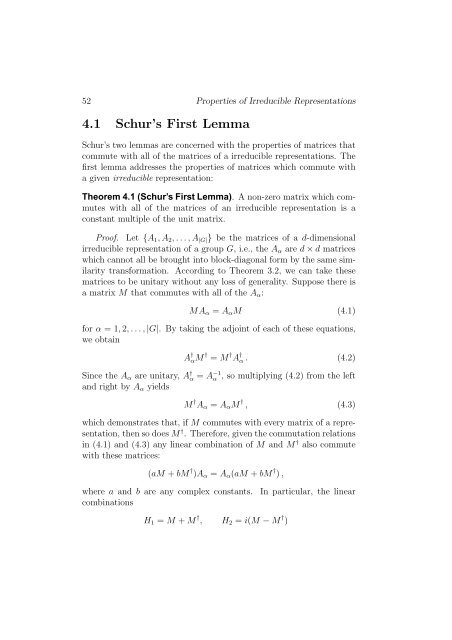Chapter 4 Properties of Irreducible Representations
Chapter 4 Properties of Irreducible Representations
Chapter 4 Properties of Irreducible Representations
Create successful ePaper yourself
Turn your PDF publications into a flip-book with our unique Google optimized e-Paper software.
52 <strong>Properties</strong> <strong>of</strong> <strong>Irreducible</strong> <strong>Representations</strong><br />
4.1 Schur’s First Lemma<br />
Schur’s two lemmas are concerned with the properties <strong>of</strong> matrices that<br />
commute with all <strong>of</strong> the matrices <strong>of</strong> a irreducible representations. The<br />
first lemma addresses the properties <strong>of</strong> matrices which commute with<br />
a given irreducible representation:<br />
Theorem 4.1 (Schur’s First Lemma). A non-zero matrix which commutes<br />
with all <strong>of</strong> the matrices <strong>of</strong> an irreducible representation is a<br />
constant multiple <strong>of</strong> the unit matrix.<br />
Pro<strong>of</strong>. Let {A 1 ,A 2 ,...,A |G| } be the matrices <strong>of</strong> a d-dimensional<br />
irreducible representation <strong>of</strong> a group G, i.e., the A α are d × d matrices<br />
which cannot all be brought into block-diagonal form by the same similarity<br />
transformation. According to Theorem 3.2, we can take these<br />
matrices to be unitary without any loss <strong>of</strong> generality. Suppose there is<br />
a matrix M that commutes with all <strong>of</strong> the A α :<br />
MA α = A α M (4.1)<br />
for α =1, 2,...,|G|. By taking the adjoint <strong>of</strong> each <strong>of</strong> these equations,<br />
we obtain<br />
A † αM † = M † A † α . (4.2)<br />
Since the A α are unitary, A † α = A −1<br />
α , so multiplying (4.2) from the left<br />
and right by A α yields<br />
M † A α = A α M † , (4.3)<br />
which demonstrates that, if M commutes with every matrix <strong>of</strong> a representation,<br />
then so does M † . Therefore, given the commutation relations<br />
in (4.1) and (4.3) any linear combination <strong>of</strong> M and M † also commute<br />
with these matrices:<br />
(aM + bM † )A α = A α (aM + bM † ) ,<br />
where a and b are any complex constants.<br />
combinations<br />
In particular, the linear<br />
H 1 = M + M † , H 2 = i(M − M † )













